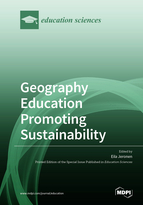Geography Education Promoting Sustainability—Series 1
A special issue of Education Sciences (ISSN 2227-7102).
Deadline for manuscript submissions: closed (30 November 2019) | Viewed by 58114
Special Issue Editor
2. Adjunct Professor, Faculty of Educational Sciences, University of Helsinki, 00014 Helsinki, Finland
3. Adjunct Professor, Faculty of Education, University of Lapland, FI-96101 Rovaniemi, Finland
Interests: education; teacher education; environmental education; sustainable development education; health education
Special Issues, Collections and Topics in MDPI journals
Special Issue Information
Dear Colleagues,
The aim of this Special Issue, “Geography Education Promoting Ssustainability” is to provide ideas of how sustainability can be promoted in teaching, studying and learning in geography. In the 2030 Agenda for Sustainable Development, it has been stated that all learners should acquire the knowledge and skills needed to promote sustainable development (United Nations, A/RES/70/1, 2015, 17). Consequently, and also with the great proliferation of knowledge and rapid changes in technology, it is important to develop students’ and student teachers’ understanding of the principles of sustainability.
The Special Issue welcomes all articles discussing views and experiences in geography education at schools and in teacher education that support curricular work and school practices sharing a vision of a society that lives in balance with Earth’s carrying capacity. In addition, your contribution can present and reflect on the ideas that offer learners a context for developing active citizenship and participation for understanding of the human–environment interactions. Articles can be review or empirical ones.
Dr. Eila Jeronen
Guest Editor
Manuscript Submission Information
Manuscripts should be submitted online at www.mdpi.com by registering and logging in to this website. Once you are registered, click here to go to the submission form. Manuscripts can be submitted until the deadline. All submissions that pass pre-check are peer-reviewed. Accepted papers will be published continuously in the journal (as soon as accepted) and will be listed together on the special issue website. Research articles, review articles as well as short communications are invited. For planned papers, a title and short abstract (about 100 words) can be sent to the Editorial Office for announcement on this website.
Submitted manuscripts should not have been published previously, nor be under consideration for publication elsewhere (except conference proceedings papers). All manuscripts are thoroughly refereed through a double-blind peer-review process. A guide for authors and other relevant information for submission of manuscripts is available on the Instructions for Authors page. Education Sciences is an international peer-reviewed open access monthly journal published by MDPI.
Please visit the Instructions for Authors page before submitting a manuscript. The Article Processing Charge (APC) for publication in this open access journal is 1800 CHF (Swiss Francs). Submitted papers should be well formatted and use good English. Authors may use MDPI's English editing service prior to publication or during author revisions.
Keywords
- subject content knowledge
- scientific skills
- student's beliefs
- student's motivation
- student's self-regulation
- education for sustainable development
- environmental education






